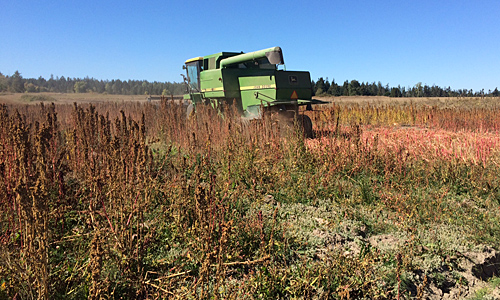
The weather gods finally smiled on us and gave us clear, dry days this week. Despite the fact that the lower portion of the field could have used another week to dry out more due to the differences in the soil moisture, we decided to take the entire field at the same time and put it into our grain dryer to ensure that it would all be dry enough to ship to the California buyer, Lundberg Family Farms.
This crop caused us some concern. When it rained, the quinoa could have molded on the stalk. If it really had been stormy, the stalks could have “lodged,” or collapsed, making it very hard to harvest with a combine. Sometimes damp seed heads will sprout right on the plant, rendering them useless. But none of these things happened, and we feel pretty lucky.
This was due, in part, to the variety, called Redhead, that was developed by Frank Morton of Wild Garden Seed in Corvallis, Oregon. Frank worked on this variety for many years, but it gets too hot in the Willamette Valley to actually grow quinoa well there. So the Lundbergs are trying it out further north. The yield did not meet our expectations, but this is our first year. Farmer Nash says it usually takes 4-5 years before you have enough experience to grow a new crop. We have a ways to go, but this wasn’t bad for a first year. In the photo, Sam McCullough harvests the quinoa crop with the 8860 combine.
